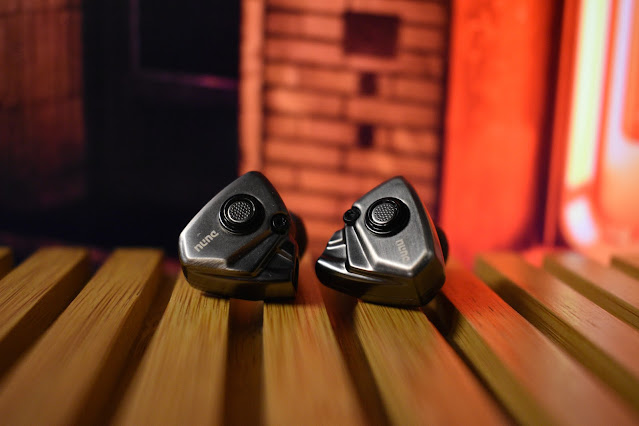- Get link
- X
- Other Apps

English | Español
Also available on YouTube in Spanish: Acho Reviews YouTube
The Titan S have been sent to me by Dunu for me to try them out and share my impressions. Dunu have not requested anything specific, therefore my review will follow the usual system of being as unbiased and sincere as possible, while keeping in mind that it has not cost me anything in order to try out these IEMs.
You can find the official Dunu Titan S page here: https://www.dunu-topsound.com/titan-s
Intro…
Dunu are a brand that I have had on my radar for quite a while but never had the chance to try until now. IEMs like the Zen, Zen Pro, and especially the SA6, have all been models that have drawn my attention and their modular cables are not only a great idea but have also been praised by many for their quality.
None of these items are really budget oriented though, so when they announced a new budget model in their line up, the Titan S, I was of course immediately interested. I have been lucky enough to be sent these out by Dunu to try and I am really glad they did.
Presentation…
The box is cheerful and colourful, showing an image of the Titan S on the front with specifications on the back.
From the coloured sleeve, a simple black box sporting the Dunu logo slides out. Removing the lid, we are greeted with a very nice carrying case, inside of which we find the IEMs, attached to their cable, but each covered with their own individual zip lock bag.
Under the case there is another smaller black box that contains the warranty card, (plenty of) replacement tips and a clip for attaching the cable to your shirt etc.
There is nothing really out of the ordinary about the way they are packed but it does show that plenty of care has been taken to pack them. I can’t complain about the amount of included tips (of multiple types), in fact, I really don’t think there is anything I would consider missing from the presentation at all.
Build and aesthetics…
Anyone who has seen a photo of the Titan S, which you obviously have if you have made it this far into the review, will have noticed the steampunk aesthetic going on. I have to say that I am a fan of the looks, they break away from the aesthetics of so many other IEMs (as do many of Dunu’s models) but I can’t deny that I was worried about fit. The thing with using strangely shaped and contoured IEMs is that there is a big risk of them being uncomfortable, but that is not the case with the Titan S (at least for me).
The size and shape of the shell does not cause me any kind of discomfort at all, as long as I am using tips that work for me, and they are also lighter than I expected from the photos. After trying the included types of tips, and a few more, I decided on the included red tips and they are what I have used for these impressions.
The build quality seems to be of high quality and Dunu have paid attention to detail, with things like the connectors being shaped to match the aesthetics of the shells.
That is something that some may see as a negative, the fact that changing the cable (even though it is a simple 2 pin) will interfere with the looks of the IEMs, but the good news is that the cable included is a very nice cable. It is a simple twisted cable which is quite thin but feels very nice and does not have a habit of tangling at all. It fits nicely together and I must say that the Go Blu with the Titan S connected via the stock cable looks great!
Sound…
Straight away I knew I was going to like the Titan S. The overall tuning is aimed towards my preferred kind of tuning and after 5 minutes of listening, I knew this was going to be an enjoyable review.
I have used these IEMs on my usual setups that I use for testing and comparisons between IEMs, but I have to say that I found these to work extremely well with the Go Blu and would be high on my list of choices for a general day to day IEM, but I am getting ahead of myself, so let’s do the usual walk through the frequency ranges.
Starting off down in the subbass, there is no real boost down there but it doesn’t roll off sharply either. I put them through the usual sub test that is “Chameleon” and I can’t say that I needed any more sub bass than what they gave me but that doesn’t mean that others won’t find themselves looking for a little more of the rumble. In more realistic scenarios, in other words with songs that aren’t aimed at destroying subwoofers, I would say that the low end is nicely balanced and works well with the overall tuning.
Moving into the mid bass category, they may be just slightly warmer than neutral but are by no means boosted. In fact, they remind me a lot of the bass found on the Aune Jasper, that is fairly neutral but with just a hint of warmth.
Listening to my usual acoustic based music, I would find myself feeling that they could have even added a little more in this area but when swapping over to other music that has more bass content, such as “No Sanctuary Here” by Marian Herzog feat. Chris Jones, I am very glad they didn’t. This is mainly due to the additional presence around the 3kHz mark but I will mention that in more detail in a moment.
I would say that the bass is maybe not the most detailed bass out there but it has a way of making things sound real. The timbre of things like acoustic guitars sound very natural and listening to “Long After You’re Gone” by Chris Jones, the air moved by the hits on the guitar body really stand out.
Moving into the mids, there is no sense of anything being missing at all throughout the mids, with a nice clean transition moving into the lower mids that doesn’t seem to get muddy not matter what I decided to listen to.
Reaching the higher end of the mids, there is a presence as we move past 3kHz that is slightly higher than normal and give voices a bit of a push forwards. I recently reviewed the Reecho SG01 that also had a bit of a boost in this area and I mentioned that this created a sensation of harshness with some music and vocals. This is not the case with the Titan S, the additional presence is a lot smoother than on the SG01. Where there was a more pronounced peak just over 2kHz, the Titan S just climbs smoothly to be and doesn’t create that harshness at all (as long as you are not listening to music that is already overly boosted in those frequencies).
I feel that another reason for the Titan S to avoid being overly present in those higher mids is due to these IEMs having a fairly decent extension in the higher ranges. For a single dynamic driver, aided by its overall tuning, the treble extension is more than acceptable, especially if we think of the price range these sit in.
This gives a nice sense of air to the IEMs and although the soundstage is not the largest out there, it is still at least average, with image placement and separation being quite good and making the most of the space they have to work with.
Detail and speed is also pretty good, again aided by the overall tuning, sounding clean and not making me have to strain to be able to focus on those details. Ok, these are not detailed in a way that something like a planar headphone is but are certainly more than adequate for what I usually expect from a sub 100€ IEM.
Vs Aria…
I don’t usually go into too many comparisons in my reviews, you can read other reviews of mine to see what I feel about other IEMs (that is why I try to keep my review system consistent) but the Moondrop Aria is something that needs to be mentioned. Ever since I received the Aria, back in May last year, they have been my go to recommendation under 100€ (and for many other people) and I think the Titan S are a serious contender for that spot, if they haven’t won it already.
The main difference between these IEMs, which sit at the same price point, is the tuning and the way they focus on different presentations. Where the Aria are a much warmer and laid back presentation, the Titan S focus on a brighter “more awake” presentation. The latter works much better for my preferences and the majority of music I listen to.
I don’t feel that the Titan S are leaps and bounds above the Aria as far as technicalities, I just feel that they present them in a way that makes it easier to appreciate them. Personally, after listening to both, I prefer the Titan S over the Aria but which you prefer will depend on your preferences and the music you listen to.
Conclusion…
The Dunu Titan S have been a nice introduction to Dunu for me. I obviously can’t say how they compare to other Dunu products but against other similarly priced (and some higher priced) alternatives, they are more than competitive.
When I think of Dunu, I think of their higher end models and their modular cables, but the Titan S is a set of IEMs that deserves a lot of attention.
I wouldn’t say the Dunu is the “best” anything in particular, but I would say that it scores well in every category and is tuned in a way that I find very pleasing. I feel that Dunu haven’t just released this IEM so that they have a model in a, lets face it, very popular price range, I feel that they have spent time on making it a good IEM, treating it as its own thing and not just dropping their name on something. Dunu have proved that they know what they are doing with their other models, and with the Titan S they have proved that they put effort into all of them, independently of the price.
If you are a fan of the looks (which I can imagine some people won’t be, but I am), and you like a tuning that is aimed more towards a neutral bright response, then the Titan S is really one of a kind, I don’t think there is anything like it on the market.
I am glad that I have had a chance to spend time with these IEMs and they have turned into a reference point for me under the 100€ mark.
All FR measurements of IEMs can be viewed and compared on achoreviews.squig.link
All isolation measurements of IEMs can be found on achoreviews.squig.link/isolation
To comment or contact, visit any of the following social media platforms:




